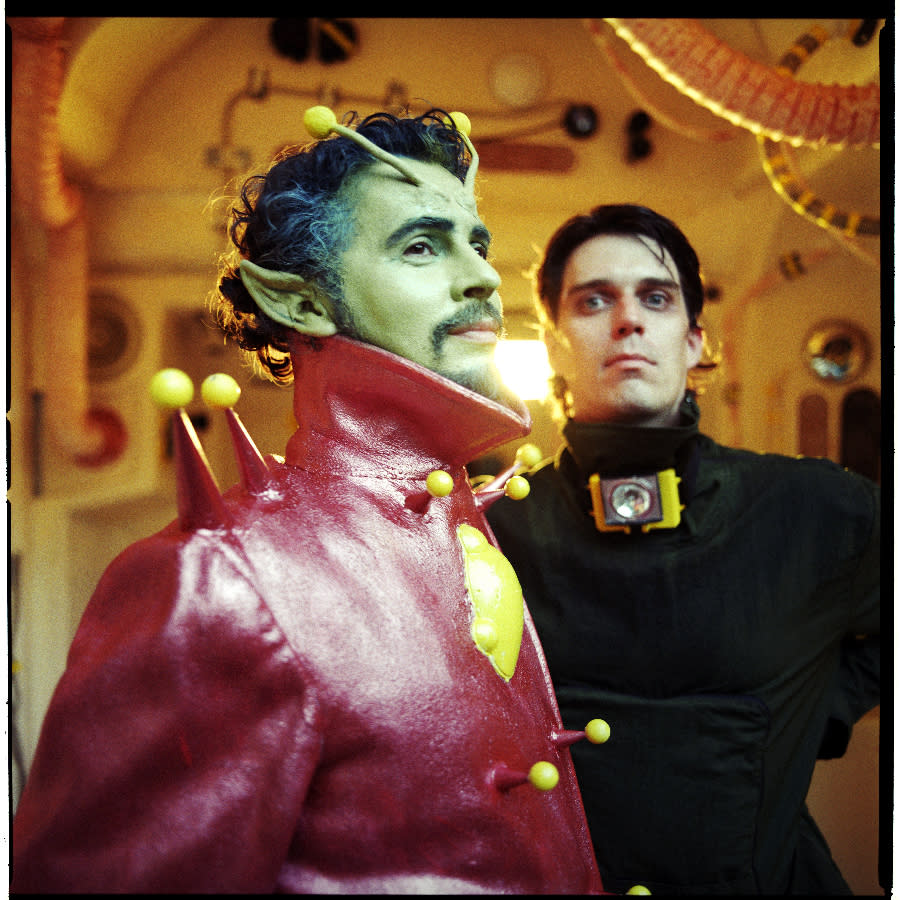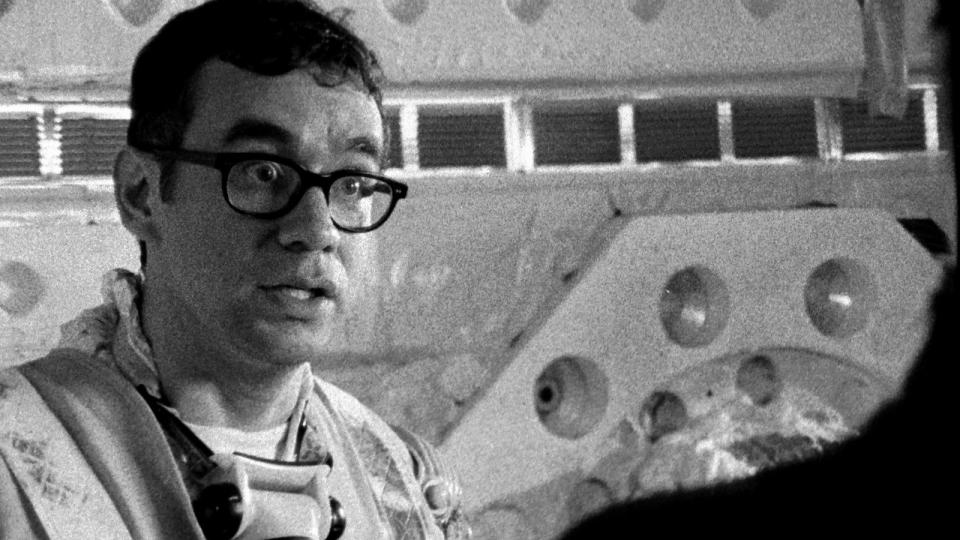Why the Flaming Lips's 'Christmas on Mars' is still the weirdest holiday movie ever
Many psychedelic seasons ago, the weirdest holiday movie you’ve likely never heard of, Christmas on Mars, by Oklahoma indie-rock eccentrics the Flaming Lips, was released to both bafflement and acclaim (OK, mostly bafflement). And it became a Christmas cult classic.
The wacky production was delayed multiple times due to the unexpected success and ensuing promotion of the band’s albums The Soft Bulletin and Yoshimi Battles the Pink Robots — the latter of which was just reissued as a 20th anniversary, six-disc boxed set on Black Friday 2022, and makes a perfect gift for the Lips fan on your holiday shopping list. The film eventually took about $200,000 of the Lips’ own money and seven years to complete.
“I’m not sure if I’m embarrassed about it or if I’m proud of it,” the band’s mastermind/frontman, Wayne Coyne, says of that long wait.
So, by the time Christmas on Mars finally made its official premiere at the 2008 Sasquatch! music festival, the film had already become the stuff of legend. However, despite all the mythology and speculation surrounding the movie, the finished product is actually way more bonkers than even the most diehard Lips devotees could have ever imagined.
Starring Flaming Lips multi-instrumentalist Steven Drozd as Major Syrtis, an astronaut on the verge of a nervous breakdown; Coyne as an antenna-headed, Santa-suited green alien; Fred Armisen, Adam Goldberg, and, in a longer and even-lesser-seen DVD director’s cut, Elijah Wood and Modest Mouse’s Isaac Brock; and a fleet of giant marching vulvas, the lo-fi sci-fi flick focuses on a Christmas pageant celebrating the birth of the first baby born on the newly colonized planet Mars.
Got all that? OK, so none of it makes very much sense. Maybe that’s because it all started as an excuse for the band to record an album of “bizarre classical-music-meets-space-age-music-meets-music-from-the-future” with the Christmas on Mars title.
“This idea of making a movie was kind of a way for us to make a soundtrack to a movie — but the movie didn’t exist,” Coyne tells Yahoo Entertainment. However, like many of the Lips’ fantastical ideas — Zaireeka, an experimental release requiring four CDs to be played simultaneously on four separate stereo systems; those limited-edition songs the Lips issued on a USB drive buried inside a life-sized, edible gummy skull; the Dead Petz side-project with Miley Cyrus; the Lips' COVID-safe bubble concerts — Christmas on Mars is a fascinating example of Coyne’s rampant, unchecked creativity at work.
“I think [making Christmas on Mars] showed me a lot about the way that I could start to do any of my ideas, any of my art, and all that, from then on,” says Coyne. “No one was demanding that we finish it. It was only my own desire to sort of say, ‘No, we must do this.’”

Speaking of “movies that don’t exist,” when Coyne decided to make Christmas on Mars, he was inspired by some very un-sugarplum-like visions that danced in his mother’s head many Christmases ago. When Coyne and his older brother came home late from a night out, his mother attempted to tell them about a strange space movie she’d just seen on television, and her wildly disjointed recap remained in his brain throughout the years.
“It goes back to a ‘movie’ my mother had seen, which now I know wasn’t a movie. It was a combination of some movies that she saw, because she would fall asleep on the couch watching movies late at night,” Coyne laughs. “I remember one night she thought she saw this movie, but it wasn’t until much later, after she died, that we figured out she didn’t really see one movie — she saw three movies, and she was falling asleep off and on and connecting them in between. We searched forever to find this movie that she thought she saw.”
Between 2001 and 2007, the Lips labored to bring Mama Coyne’s fake dream-state film(s) to the screen, sporadically shooting Christmas on Mars (at first on 16mm film, and then later, as home moviemaking technology rapidly advanced, on digital formats) at various locales around their native OKC — including dilapidated industrial facilities and homemade sets in Coyne’s compound of connected houses and backyard.
“Some of it we would shoot literally just in my house. I have a huge, crazy house in Oklahoma City,” Coyne says. “At the time, the back part of the house was still being renovated, so there would be rooms that were kind of just tore up, and I made them look like they were rooms inside a space station or whatever on Mars. … At the time, there was a crack house that was an abandoned little shack that was in the back of one of these houses that I had recently bought, and instead of tearing it down, I just turned it into another scene. So I’m literally shooting in my house, and literally shooting in my own backyard, and the scene that’s got Fred Armisen in it is shot in that crack house.”

Coyne also shot in Austin during the 2004 South by Southwest festival to accommodate Goldberg’s schedule, and it turned out to be well worth it. “I said, ‘Well, if you’re gonna be there for four days, I’ll build a set in Austin. All you gotta do is come over there.’ He said, ‘If you can do that, dude, I’ll be yours for a whole day and a whole night. Whatever it takes, from the beginning of the morning to the end of the night.’ He had, like, four pages of dialogue, and I saw him literally go off to a room 20 minutes before we shot, read through it, and then he came in and did probably 50 takes. Every one of the takes was stunning. I remember we would forget that we were even shooting a movie. We’d be like, ‘Oh, f***. Sorry. Cut!’ He was so amazing.”
Coyne admits with a self-deprecating chuckle and shrug that he and his bandmates and cast of assembled local pals weren’t as skilled at acting as Goldberg, but he believes that is part of the film’s DIY charm. “There’s bits of it where the acting is weird, or it’s awkward, or bad, or ridiculous, but that was our way of saying, ‘I know, but this is us making a movie. We’re not really trying to win the Cannes Film Festival this year. We’re just making this with our friends and our family. It really is a vehicle by which we can put our music and other abstract ideas into.’
“And you know, I’m not trying to be a movie director,” Coyne adds with a laugh. “I wasn’t waiting on someone to call me and say, ‘Hey, we saw Christmas on Mars. Would you wanna make our movie?’ I’m just making my own movie, my own way. This isn’t me auditioning for other director’s jobs!”
The result wasn’t exactly a feel-good family film: A decade and a half later, Christmas on Mars is still best remembered for the above-mentioned vulva-army scene, set to an experimental instrumental titled “The Gleaming Armament of Marching Genitalia.” (Side note/fun fact: A year after Christmas on Mars’s brief theatrical release, the Flaming Lips expounded upon their weird version of this “nativity scene” of sorts, by releasing a limited-edition Christmas tree ornament shaped like a fetus.)
Coyne breathlessly attempts to explain this vaginal symbolism to Yahoo Entertainment. “It went along the concept that this baby was being born outside of its real mother [in a manmade plastic space-womb], and that this is the way babies will be born 100 years from now. They’ll be in an incubated thing looked over by the parents, but it won’t actually be inside the woman or man. That was the concept there,” he begins. “So, the one main character [Drozd’s Major Syrtis], he’s haunted. He sees this baby in there, and he’s living on Mars, and the oxygen’s weird, and the oxygen generator breaks. All these things sort of cause him to have this breakdown, which leads to hallucinations. And so this dream that he thinks he’s having is really a hallucination the entire space station is having. Somehow on some deep humanistic level, this way of a baby being born, without being inside of its mother, is causing some humanistic break. And that’s what they were trying to come to grips with. That’s what that parade is. He’s telling people about this horrible dream of the baby being crushed by a marching band whose heads are … yeah, they’re giant, flopping women’s vaginas.
“Yeah. I mean, it’s a scene that only we would make.”
Obviously the dystopian Christmas on Mars has more in common with Eraserhead than with popular holiday fare like, say, It’s a Wonderful Life or Love, Actually. But Coyne insists that, despite all of its disturbing imagery and soundtrack song titles like “The Horrors of Isolation: The Celestial Dissolve, Triumphant Hallucination, Light Being Absorbed,” “The Secret of Immortality: This Strange Feeling, This Impossible World,” “Space Bible with Volume Lumps,” and “In Excelsior Vaginalistic,” the movie does offer a Christmas-appropriate, if vague, message of hope.
“To me, Christmas on Mars is like a situation,” Coyne explains. “Mars is the situation that this is completely brutal, and this is completely unknown. And we don’t know what to do. And you know, we invented Christmas on the darkest day in the northern part of the world. On the darkest days of the year, we put lights in our trees. And that’s what I would tell everybody: On the darkest days of your life, you have to put lights in your trees, whatever your ‘trees’ may be. It’s like you saying, ‘I know I’m playing along with this ridiculous fantasy, but it actually works.’ That’s what we mean when we say ‘Christmas on Mars.’ Christmas is the made-up fantasy scenario that will bring you happiness in the face of this utter unknown, bleak void.”
Years after they released Christmas on Mars into the void, the Lips, whose other holiday cult carols include "Christmas at the Zoo" and "A Change at Christmas," are still celebrating Christmas as only they can — in recent years, they've released their own psychedelic version of the beloved Bing Crosby/David Bowie duet, “Peace on Earth”/“Little Drummer Boy.” And Coyne looking forward to forming new holiday traditions as he and his wife Katy celebrate with their young sons, 3-year-old Bloom and 9-month-old Rex.
“For me, every day when you’re a little boy is like Christmas already. … I mean, for me, I get to live like a whole ’nother life now. This is the beginning of my second life. I’m like, ‘Let’s go, motherf***er!’” says Coyne, age 61. “Our house is already made for little kids, and we don’t always get that much sleep already, so it’s not... that much different for us.”
As for whether Christmas on Mars will ever become a more widely viewed or loved family holiday classic in decades to come, Coyne knows that, like fruitcake, the film is an acquired taste. “We do make weird f***ing music. Not everybody in the world’s gonna understand it,” he admits. “But I feel like the people that do understand it are people that understand it the way I do. It’s emotional. We’re not just having a party. It’s hitting something very down to the core. I think Christmas on Mars has that reach, too. It’s not trying to really entertain you on your conscious level.”
Read more from Yahoo Entertainment:
Kris Cringe-worthy! These are the 4 weirdest Santa Claus movies ever made
Wayne Coyne remembers the Flaming Lips playing ‘90210’s’ Peach Pit
'The Star Wars Holiday Special' at 40: How a landmark TV bomb was born
Wayne Coyne talks Miley Cyrus connection: ‘She’s just got a bigger brain’
Wayne Coyne on why the Flaming Lips's bubble concerts are 'safer than going to the grocery store'

